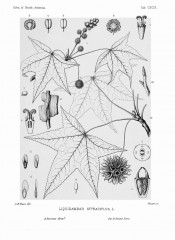Liquidambar styraciflua L.
Fully hardy, broadly conical, deciduous tree, with palmate, 5-7 lobed, glossy leaves, to 15cm across, which turn orange, red and purple in autumn. To 25m. [RHSE, Hortus, Hilliers’].
Horticultural & Botanical History
‘Liquidambar Styraciflua is distributed from Fairfield County, Connecticut, to southeastern Missouri, southward to Cape Canaveral and the shores of Tampa Bay, Florida, and through Arkansas and the Indian Territory to the valley of the Trinity River in Texas; it reappears on the mountains of central and southern Mexico and ranges southward to the highlands of Guatemala. In some parts of the United States, especially in the maritime region of the southern Atlantic states and in the basin of the lower Mississippi River, the Sweet Gum is one of the most common trees in the forests of low rich river-bottom lands which are usually inundated every year; in such situations, growing with the Cotton Gum, the Chestnut White Oak, the Willow Oak, the Red Maple, the Black Gum, and the Water Ash, it develops tall straight trunks free from branches to a height of seventy or eighty feet above the ground. In the northern and middle states it is found on the borders of swamps and in low wet swales, where in company with the Red Maple, the Swamp White Oak, the Tupelo, the White Ash, and the Red Ash, it often grows in great numbers; occasionally the Sweet Gum appears on drier and more elevated ground, where it remains small; and in the north it rarely grows more than sixty or seventy feet tall or produces a trunk more than two feet in diameter.
The wood of Liquidambar Styraciflua is heavy, hard, straight, and close-grained, although not very strong; it is bright brown tinged with red, with thin almost white sapwood composed of sixty or seventy layers of annual growth. The specific gravity of the absolutely dry wood is 0.5910, a cubic foot weighing 36.83 pounds. The wood of the Sweet Gum is smooth and satiny and can be made to take a beautiful polish; it is difficult to season and warps and shrinks badly in drying, but in spite of this serious defect it is now used in large quantities, especially in the western states, in the outside finish of houses, in cabinet-making, for street-pavements, cheap dishes, and fruit-boxes. The leaves contain tannin, and have been recommended as a substitute for Oak-bark for tanning leather.
In 1615 the first account of this tree from the pen of the Spanish naturalist Hernandez was published in the City of Mexico, and the resin, which resembled the liquid storax of the east, soon attracted the attention of European pharmacists. It was introduced from Virginia into England, and was cultivated before 1688 by Bishop Compton in his garden at Fulham.’ [Sargent – The Silva of North America vol.5, p.11, tab.CXCIX/1893].
As an ornament for parks and roadsides in the middle and southern states, few trees are more valuable than the Sweet Gum. It grows rapidly and is not particular about soil; its habit, although rather regular before it reaches maturity, adapts it to formal planting; the leaves are unsurpassed in beauty of form, in lustre, or in the brilliancy of their autumnal tints; and in winter its broadly winged branches make it a curious and interesting object.
‘When an incision is made through the bark of this tree, a resinous juice exudes, which possesses an agreeable balsamic odour. It is currently collected and sold under the name of gum-wax. It is a much more agreeable masticatory than the spruce-gum, and is chewed in the West [of the United States] by nearly all classes’. [Gard. Chron. 1856]. Introduced to Europe in 1683. [JD].
History at Camden Park
Listed in all published catalogues [T.640/1843].
Notes
Published Mar 20, 2009 - 02:19 PM | Last updated Jul 21, 2010 - 05:46 PM
| Family | Hamamelidaceae |
|---|---|
| Category | |
| Region of origin | Eastern North America |
| Synonyms |
|
| Common Name | Sweet gum, Liquidambar |
| Name in the Camden Park Record | Liquidambar styraciflua - Sweet Gum-tree |
| Confidence level | high |
